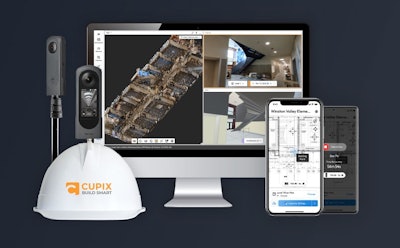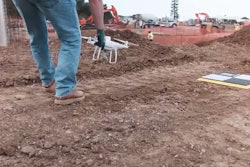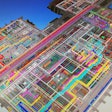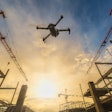
Construction reality capture software is advancing in the methods contractors can use to ingest information about the physical world—encompassing drone photogrammetry data, handheld and wearable cameras, Lidar scanners, 360-degree cameras, even cell phone cameras. The technology is also advancing in how contractors can then use that information.
Openspace is focused on adding capabilities for progress tracking. Avvir focuses on identifying and managing discrepancies. San Jose, Cal.-based Cupix, meanwhile, lays claim to those capabilities while going further with reality capture that turns 360 video into a point cloud.
The company has enough employees to push themselves from raw startup to middle-market in size, which should comfort conservative executives considering startup technology. These employees are located around the world, including a distributed customer success team so service and support can follow the sun. The company has raised about $40 million in capital according to sources inside the company and is actively hiring to build out its sales team, which suggests a commitment to growing revenue and market footprint in 2024 and beyond. Cupix was founded in 2015, had an initial product in closed beta by the end of 2016 and a public free beta by late 2017 that enabled users with an off-the-shelf 360-degree camera to capture 1,000 square feet of space with just 12 photos.
First Generation Product
By 2021, Cupix released to market CupixWorks 2.0, a 3D digital twin application that according to a release delivered:
- Automated 3D spatial information extraction and editing tools which enable 3D spatial intelligence-based site management
- BIM data support
- Secure collaboration and data access controls
IRONPROS caught up with Cupix Vice President of Product Marketing Chuck Pfeffer on a December, 2023 discovery call.
“Each customer has a team of effectively three people that can cover them from setup to maintenance and more significant support depending on the type of system they're running and which subscription they're using from us,” Pfeffer said.
Time to value can be extremely short, or accrue as customers implement more sophisticated CupixWorks’ capabilities.
“It could be same day, it depends on which level of service they're using, but the basic service where you're just doing a video walk with a camera, and uploading it into the system—that can be running straight away,” Pfeffer said. “… If they're going to be uploading BIM, and coordinating models and aligning their system, then it could be a couple days to be up and running. If they're doing automatic progress tracking, it requires integration of P6 or Microsoft Schedule and the BIM. They are actually synchronized together and aligned to their capture. Then, you could be talking anywhere from a couple of weeks to a month of prep, working closely with that customer to set that process in motion. And then once it's set up, it runs automatically.”
Currently, Cupixworks is available in three tiers:
- Essentials, which enables users to capture, visualize and share the capture with the construction team.
- Builders adds time-based scans and BIM integration
- Unified adds the ability to bring in data from external sources including laser scans or other point cloud or photogrammetry files
Pfeffer said in January of 2024, Cupix will release augmented reality functionality that will enable CupixWorks users to view their historical visualizations on the job site after scanning a QR code to locate the tablet or phone.
Cupix’s secret sauce though is probably still the ability to output point clouds from a 360-degree photo capture.
“We use proprietary algorithms that also incorporate AI,” Pfeffer said. “The way we've developed that process is a step above what most other companies are doing with video capture. The point cloud is the backbone of everything else that is done in CupixWorks. Because you have the point cloud in the background, your measurements are more accurate, you can do distance, area, volume, radius—there’s all sorts of easy, simple measurements. But you also can use it for scan-to-BIM workflows. It’s not as accurate as a laser scan, but it gives you 98 to 99% of the accuracy of a laser scan for applications where you need to create a 2D plan or a 3D BIM from a quick point cloud. It's great for estimating at the front end of a job. It's good as a deliverable for requirements that just need a low-cost floor plan.”
Cupix may lead in generating point clouds from photogrammetry, providing greater accuracy, but here is a closeup look at two other leading vendors in construction photogrammetry.
4D BIM and Progress Tracking
Important integrations include Autodesk BIM 360 and Autodesk Construction Cloud, Procore, Plangrid, ArcGIS Viewer, Matterport Viewer and Bentley iTwin Viewer.
“You’re connecting directly to the Autodesk Construction Cloud,” Pfeffer offers by way of example. “It brings in the Navisworks version, so every day you're going to get the latest and greatest from your BIM. It won't be dated, it won't be imported. All of this is happening on the cloud, so it's available from any browser for anyone on the project and so everyone has the most up-to-date reality capture and BIM at their fingertips all the time.”
Cupix Tech Stack
According to Pfeffer, the cloud components of CupixWorks are provisioned on AWS, but is fairly cloud agnostic and can run in other cloud environments if required. New product is shipped to the could about twice a month, with larger block functional releases more sporadically.
“We find something that we think has importance, make a priority of it, and it comes out pretty quick,” Pfeffer said. “And our customers appreciate that. They are always a huge driving force in what we do next and we listen to them.
On site, an operator can connect their iOS or Android device to an approved 360-degree camera. Recommended cameras include the Ricoh Theta X, Insta360 ONE X2, and Insta360 ONE RS 1-inch 360.
“We do some extensive testing of our cameras that we recommend to ensure we deliver the point cloud that we want,” Pfeffer said. "Not all 360 cameras are as good for that purpose, but we have identified several of them, and they're not that expensive. They’re, like, $400 cameras.”

In November of 2023, Ricoh and Cupix announced a strategic partnership that introduced the Ricoh Theta X as a supported product. This camera features integrated GPS technology for precise location and mapping capabilities and strong performance in low light conditions.
CupixWorks Pricing and Market
The flexible pricing tiers and simplicity means there are few hard barriers to who can make Cupix a good investment based on company or project size alone, but some contractors will find CupixWorks a more natural fit than others.
“The best fit is really the general contractor who's managing the project and managing a number of subs as well,” Pfeffer said. “Everybody can have visibility of everything that's happening. But we found that the typically the person at that GC that's championing this solution is a BIM or VDC manager. They're usually the person responsible for bringing technology into their processes. They tend to test it and implement it on a project, and then try and get other projects to use it.”
But other types of organizations are also making productive use of CupixWorks.
“An architect who might have been hiring a scanning service to come in to get an as-built to get started or even after a project could just buy a camera for $400 and get started for just a few thousand,” Pfeffer said. “Some of those GCs have their business development people going out with cameras when they're just scoping out a job, walking the site for the first time. They'll collect the scan, and then with CupixWorks all their estimators see it immediately and start doing their estimates without having to send all the engineers to the to the job site. At the end of the job being able to deliver a digital twin to a facilities manager is also something that can be packaged and can be a selling point for the GC. We also have owners and owner reps who do this.”
CupixWorks pricing is based on multiple factors, including the square footage, and the timeframe and complexity of the project.
“A box warehouse is different than a hospital, where the detail is different,” Pfeffer said. “So in some cases, you get a break on the square footage if it's a very simple open area … But once a customer gets up to speed and they bring it to a corporate level, then we start talking about enterprise agreements, and those are worked out with those customers individually.”
BOTTOM LINE: Cupix has strong IP for data capture at the tip of the spear, and the fact that underlying analytical features are driven by a point cloud may help the company distinguish itself in functionality like progress tracking and deviation management. The technology from all vendors in this space is evolving rapidly, but Cupix watchers may want to pay as much attention to progress towards building out a sales and go-to-market team as they do to advancing functionality.















